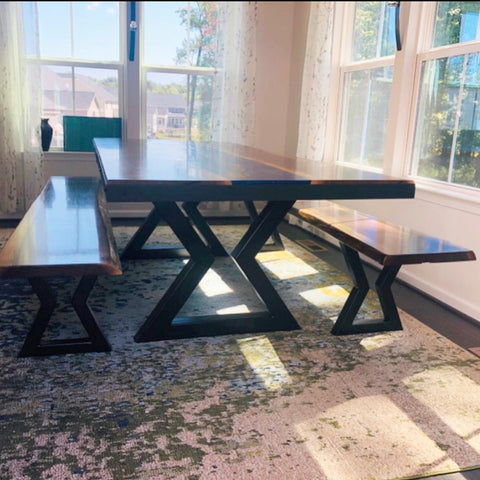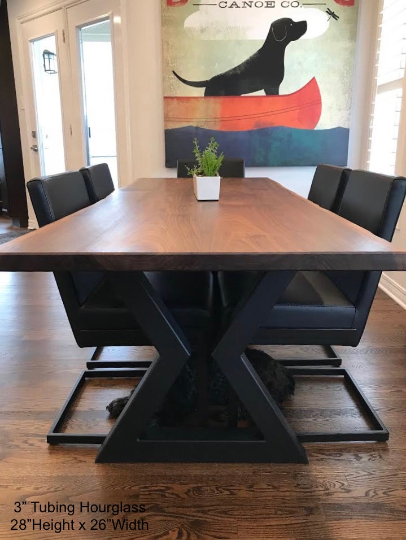Just How to Choose the Perfect Dining-room Table Legs for Your Home Décor
Selecting the perfect dining room table legs is a nuanced procedure that calls for cautious consideration of different elements, including your space restraints, visual choices, and useful needs. The interplay in between dimensions, designs, and products can considerably influence the setting of your eating area, making it essential to approach this choice systematically.
Assess Your Dining Room
Analyzing your dining space is critical for choosing the right table legs that complement both aesthetic appeals and functionality. Begin by measuring the measurements of your eating location, including ceiling elevation, floor area, and proximity to other furnishings. This details will certainly aid figure out the suitable dimension and height of your table, which directly affects the option of table legs.
Following, consider the style and format of your dining area. For instance, an open-concept style might gain from table legs that use visual lightness, such as slim steel or acrylic alternatives. On the other hand, a much more standard setup could require tough wooden legs that offer a feeling of permanence.
Review the existing color combination and products in your dining area. Harmonizing the table legs with these elements produces a cohesive look that improves the general style.
Eventually, a comprehensive assessment of your eating area will lead you in making a notified choice, making certain that your table legs not just enhance the visual allure but also serve practical purposes.
Consider Your Design Preferences
When picking dining area table legs, it is necessary to assess your individual design preferences, as they significantly influence the general visual of your dining area. Your selection of table legs can either complement or contrast with existing decoration, making it essential to straighten them with your preferred interior decoration theme.
If your home leans in the direction of a contemporary visual, consider smooth metal or minimalist wooden legs that provide a clean, uncluttered look. For a more typical strategy, ornate wood legs with detailed carvings can include a touch of elegance and elegance. Industrial styles gain from robust, basic materials such as reclaimed wood and steel mixes, reflecting a sturdy charm.
Furthermore, farmhouse and rustic styles usually favor durable, chunky legs that evoke a feeling of warmth and comfort. Conversely, if your design is diverse, you could choose unconventional forms or a mix of materials to develop visual interest.

Evaluate Material Options
The selection of material for dining space table legs plays a crucial role in both sturdiness and visual allure. Typical products consist of timber, metal, and composite alternatives, each offering unique attributes that can influence the total look and longevity of your table.
Wood is a classic option, understood for its heat and adaptability. Hardwoods like oak and walnut offer extraordinary strength and can be finished in various discolorations to match any style. Softwoods like yearn are extra prone to damages and scrapes, making them less perfect for high-traffic anonymous areas.
Steel legs, frequently crafted from steel or aluminum, radiate modernity and industrial appeal. They are very sturdy and resistant to wear, making them appropriate for family members with kids or regular gatherings (dining room table legs). Furthermore, steel can be ended up in various colors, boosting the modification possibilities
Composite products, such as MDF or laminate, deal affordability and varied layouts. While typically less sturdy than solid timber or metal, they can still offer an elegant look and are often easy to keep.
Ultimately, the material you select need to line up with your way of life, visual choices, and the level of use your table will experience.
Determine Elevation and Dimension
Picking the suitable elevation and size for your eating room table is necessary for both functionality and comfort. The basic elevation for dining tables usually ranges from 28 to 30 inches, enabling sufficient legroom for most people when seated. It is crucial to consider the dimensions of your eating area and address the kinds of chairs you prepare to use.

Moreover, take into consideration the proportions of your dining-room. A larger table in a large area can create a grand setting, while a smaller table works well in even more intimate setups. Ultimately, the appropriate elevation and size will balance with your overall design and enhance the dining experience for you and your visitors.
Explore Personalization Opportunities

Additionally, the layout of the legs can be tailored to fit various styles, such as rustic, contemporary, or commercial. Tapered legs can evoke a mid-century modern feeling, while chunky, block-style legs might reverberate with traditional or farmhouse design.
House owners can likewise check out shade surfaces, from all-natural wood spots to repaint, allowing them to match or contrast with the table top and bordering decor.
Additionally, leg height can be adapted to accommodate certain seating plans or individual preferences, boosting both comfort and performance.
Lastly, special embellishments, such as carvings or attractive brackets, can additionally personalize the table legs, making the dining experience not simply a declaration however a meal piece in the home. By taking into consideration these personalization options, property owners can develop a dining space table that truly shows their originality.
Conclusion
Choosing the excellent dining-room table legs needs mindful consideration of browse around here different aspects, consisting of the dimensions of the dining area, design choices, product sturdiness, and wanted elevation. Customization options additionally boost the capacity to attain a cohesive aesthetic that complements the general decoration. By methodically reviewing these components, homeowners can guarantee that the selected table legs not only meet practical demands yet additionally add favorably to the eating experience and atmosphere of the home.
Picking the optimal dining space table legs is a nuanced process that needs careful consideration of various elements, including your space constraints, visual choices, and sensible demands.Examining your eating area is important for choosing the right table legs that complement both aesthetic appeals and performance.When identifying size, measure the location where the table will certainly be put to ensure it fits comfortably, permitting for at the very least 36 inches of clearance around the table for simple movement. A bigger table in a sizable area can create a grand setting, while a smaller sized table works well in more intimate setups.Choosing the perfect eating area table legs needs careful factor to consider of different factors, consisting of the dimensions of the dining room, style choices, product resilience, and desired elevation.